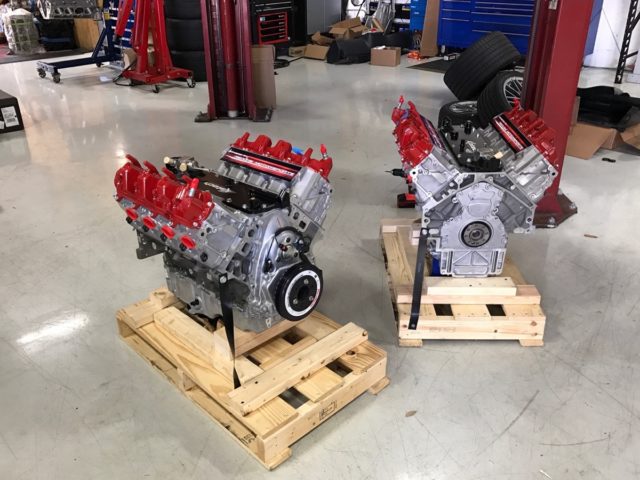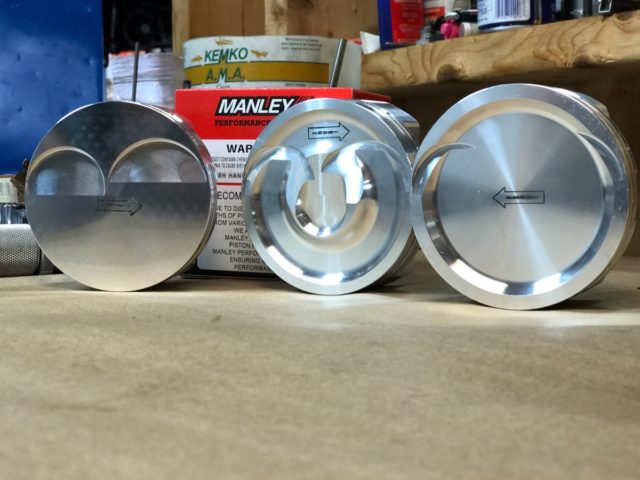In the early days of EFI, you literally had to throw quite a bit of the OEM designs into the garbage can if you wanted a modified engine to run properly and make power. Thankfully that isn’t the case today, which is why builders and tuners tend to take a more conservative approach. For example, when the aftermarket started generating pistons for the direct injection Ford EcoBoost and GM Gen V V8s, they decided to mimic the fuel bowl on the OEM pistons. Of course, it doesn’t take long before someone challenges such convention.
“We make the fuel bowl on our standard pistons, but we wanted to test a set without it,” according to Tom Razzano at Manley Performance. Enter Redline Motorsports, who have been meddling with GM’s Gen V engines since they hit the streets. Redline’s new Gen V engine program provided the perfect opportunity to test a unique piston design.
“A couple years ago when we built our 427 cubic inch, twin turbo 2016 Camaro, we were in a bind to lower the compression for a boosted application,” recalled Howard Tanner of Redline. “We had built several direct injection motors prior which all retained the ‘sugar scooper’ [aka fuel bowl] design but found it necessary to remove it to get the piston dish we needed to hit our compression goals. Bit of a gamble but no pain, no glory.”
Razzano justifies that no such fuel bowl is needed for Lamborghini V10s to make 2,500 horsepower in the hands of Underground Racing and their ilk. “I decided to fast-track this idea after a conversation with Paul Yaw at Injector Dynamics. We agreed that the direct injection dish was for cold-start and I wanted to see results without the dish.” It’s fairly common knowledge that OE emissions testing occurs from the first second the engine fires, when it is least efficient.
“The first two or three miles in a typical 22-minute, 12-mile commute in today’s vehicles result in the emission of half of the total non- methane hydrocarbons, which result in the production of urban smog, as well as half of the toxic CO emissions,” according to the EPA. “This occurs because the catalyst in the converter will operate ineffectively until it reaches its optimal operating temperature.” Development of technology to heat up the cats quicker has been happening since the early ‘90s.
According to Razzano and Tanner, the fuel bowl serves to help heat up the catalytic converter as fast as possible. To quote legendary scribe Jeff Smith, it redirects “the fuel spray upwards toward the exhaust side of the chamber near the spark plug.” Prior thoughts on the fuel bowl, however, were more concentrated on the latter part of that statement.
Most credit the fuel bowl as a means of concentrating fuel near the spark plug for a more thorough and efficient burn. A standard piston crown, by comparison, would allow more fuel to push to the outer circumference of the piston. In theory, the fuel bowl plays a part in reducing pre-ignition and allows for higher compression ratios.
Tanner asserts, though, “Much to popular belief; the fuel bowl is not as important to performance as it is for emissions. The ‘sugar scooper,’ as we call it, is designed to shovel fuel towards the exhaust port. This is important during cold-start to help ‘light off’ the catalyst. This is done in conjunction of retarding the spark advance and the camshaft position.”
Despite lacking the “sugar scooper” as he called it, the twin-turbo Camaro experienced no ill-effects. “As it would be, the car actually starts up better than it did stock and we had no problem making about 1,000 wheel horsepower. Case closed,” Tanner concluded. While the Camaro’s 427 LT1 has a 10.5:1 compression, Redline typically does not lower compression for boosted applications thanks to the efficiency of direct injection.
One of Redline’s other experiments with Manley include a 12.3:1 naturally aspirated engine that locked out the variable valve timing. “VVT is not as great as we think, especially in stock form. Again the concept was for emissions and fuel economy. In order to take advantage of this technology we actually built a 416 cubic-inch motor and had Manley build us a piston with some deeper valve reliefs. Then got together with Comp and had a camshaft ground with a great amount of advance. We then used the phaser to retard back what we needed. This created a super flat torque curve but without this coordination with the cam specs and piston design you couldn’t do this on a stock engine.”
Manley has tested a number of piston designs with Redline to best suit a host of boosted and naturally aspirated LT1 builds. Razzano asserted that other aspects of the piston design such as the skirt are a carryover from the LS, “It’s a proven design that we use in a lot of platforms. The shape promotes stability and that leads to ring seal. When a piston is under distress it will lose ring seal and thus lose power. Our pistons will not be the lightest on the market but they will live and make power. We’ve made pistons for all forms of racing for years and our pistons just helped set the world record for the quickest and fastest GT-R. It was the first to go 6s and makes around 3,000 horsepower.”
Manley’s LT1 pistons are made from 2618 alloy aluminum with an offset wrist pin. Standard pistons come with chrome moly wrist pins while the Extreme Duty versions feature 9310 alloy. Moly coated skirts are standard for all. For more information, check out Manley’s product page.






















